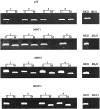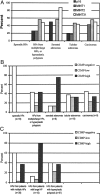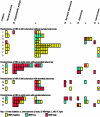Concordant CpG island methylation in hyperplastic polyposis
- PMID: 11839573
- PMCID: PMC1850645
- DOI: 10.1016/S0002-9440(10)64872-9
Concordant CpG island methylation in hyperplastic polyposis
Abstract
The CpG island methylator phenotype (CIMP) is a newly described mechanism for carcinogenesis in colorectal carcinomas and adenomas characterized by methylation of multiple CpG islands. The causes of CIMP are unknown. We studied CIMP in hyperplastic polyps (HPs), with emphasis on patients with multiple HPs (5 to 10 HPs), large HPs (one HP >1 cm) or hyperplastic polyposis (>20 HPs). Methylation of p16, MINT1, MINT2, MINT31, and hMLH1 was analyzed by methylation-specific polymerase chain reaction in 102 HPs, 8 serrated adenomas, 19 tubular adenomas, and 9 adenocarcinomas from 17 patients, with multiple/large HPs or hyperplastic polyposis and in 16 sporadic HPs from 14 additional patients. Sporadic HPs were CIMP-negative (not methylated at any locus), but 43% of HPs from multiple/large HPs, or hyperplastic polyposis were CIMP-high (two or more methylated loci, P = 0.00001). Methylation among the four loci was correlated within HPs (odds ratio, 3.41; P = 0.002), and the methylation status of HPs within the same patient was also correlated (odds ratio, 5.92; P = 0.0001). CIMP-high HPs were present primarily in patients with a predominance of HPs in the right colon and/or serrated adenomas (P = 0.0009) and were associated with the absence of K-ras proto-oncogene mutations (odds ratio, 5.08; P = 0.03). Our findings of concordant CpG island methylation of HPs in multiple/large HPs or hyperplastic polyposis supports the concept that some patients have a hypermethylator phenotype characterized by methylation of multiple HPs and other colorectal lesions. The hypermethylator phenotype is related to patient-specific factors, such as carcinogenic exposure or genetic predisposition.
Figures




Similar articles
-
Molecular features of colorectal hyperplastic polyps and sessile serrated adenoma/polyps from Korea.Am J Surg Pathol. 2011 Sep;35(9):1274-86. doi: 10.1097/PAS.0b013e318224cd2e. Am J Surg Pathol. 2011. PMID: 21836485
-
Frequent CpG island methylation in serrated adenomas of the colorectum.Am J Pathol. 2003 Mar;162(3):815-22. doi: 10.1016/S0002-9440(10)63878-3. Am J Pathol. 2003. PMID: 12598316 Free PMC article.
-
BRAF mutations in aberrant crypt foci and hyperplastic polyposis.Am J Pathol. 2005 Apr;166(4):1069-75. doi: 10.1016/S0002-9440(10)62327-9. Am J Pathol. 2005. PMID: 15793287 Free PMC article.
-
The case for a genetic predisposition to serrated neoplasia in the colorectum: hypothesis and review of the literature.Cancer Epidemiol Biomarkers Prev. 2006 Oct;15(10):1778-84. doi: 10.1158/1055-9965.EPI-06-0164. Cancer Epidemiol Biomarkers Prev. 2006. PMID: 17035382 Review.
-
CpG Island Methylator Phenotype-High Colorectal Cancers and Their Prognostic Implications and Relationships with the Serrated Neoplasia Pathway.Gut Liver. 2017 Jan 15;11(1):38-46. doi: 10.5009/gnl15535. Gut Liver. 2017. PMID: 27885175 Free PMC article. Review.
Cited by
-
Emerging trends in colorectal cancer: Dysregulated signaling pathways (Review).Int J Mol Med. 2021 Mar;47(3):14. doi: 10.3892/ijmm.2021.4847. Epub 2021 Jan 7. Int J Mol Med. 2021. PMID: 33655327 Free PMC article.
-
Hyperplastic polyps are innocuous lesions in hereditary nonpolyposis colorectal cancers.Int J Surg Oncol. 2011;2011:653163. doi: 10.1155/2011/653163. Epub 2011 Jun 7. Int J Surg Oncol. 2011. PMID: 22312515 Free PMC article.
-
Multiple sporadic colorectal cancers display a unique methylation phenotype.PLoS One. 2014 Mar 18;9(3):e91033. doi: 10.1371/journal.pone.0091033. eCollection 2014. PLoS One. 2014. PMID: 24643221 Free PMC article.
-
Detection of viral DNA sequences in sporadic colorectal cancers in relation to CpG island methylation and methylator phenotype.Tumour Biol. 2011 Aug;32(4):653-9. doi: 10.1007/s13277-011-0165-6. Epub 2011 Apr 6. Tumour Biol. 2011. PMID: 21625944 Free PMC article.
-
Over-expression of cathepsin E and trefoil factor 1 in sessile serrated adenomas of the colorectum identified by gene expression analysis.Virchows Arch. 2009 Mar;454(3):291-302. doi: 10.1007/s00428-009-0731-0. Epub 2009 Jan 27. Virchows Arch. 2009. PMID: 19172291
References
-
- Kinzler KW, Vogelstein B: Lessons from hereditary colorectal cancer. Cell 1996, 87:159-170 - PubMed
-
- Reale MA, Fearon ER: Gene defects in colorectal tumorigenesis. Young GP Rozen P Levin B eds. Prevention and Early Detection of Colorectal Cancer. 1996, :pp 63-86 WB Saunders Company, Ltd., London
-
- Fearon ER, Dang CV: Cancer genetics: tumor suppressor meets oncogene. Curr Biol 1999, 9:R62-R65 - PubMed
-
- Perucho M: Microsatellite instability: the mutator that mutates the other mutator. Nat Med 1996, 2:630-631 - PubMed
-
- Chung DC: The genetic basis of colorectal cancer: insights into critical pathways of tumorigenesis. Gastroenterology 2000, 119:854-865 - PubMed
MeSH terms
LinkOut - more resources
Full Text Sources
Other Literature Sources
Medical
Research Materials
Miscellaneous

